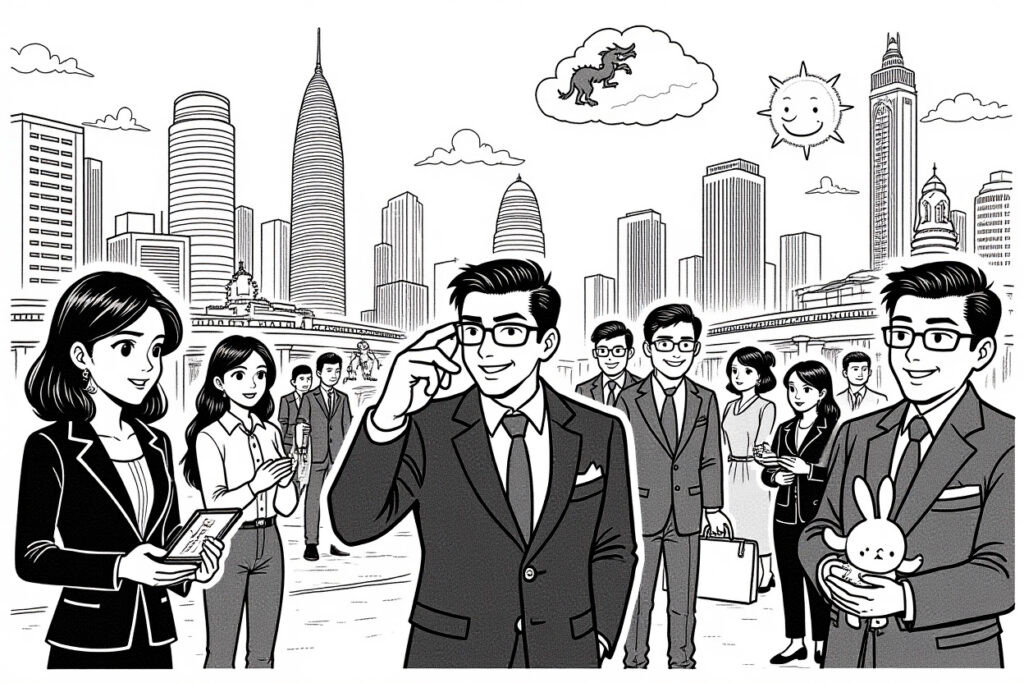The Battle for Dominance in China’s EV Arena
On the competitive poker table of China’s new energy vehicle market, three internet-born founders are facing their most brutal reshuffle since founding their companies. The recent launches—the Li Auto i8 and the NIO-led brand Ledao’s L90—are seen as desperate, last-stand transformations for Li Auto and NIO, respectively. Meanwhile, the newly unveiled XPeng P7 carries the hope of XPeng’s return to the premium market segment.
The debut of the Li Auto i8 and Ledao L90 immediately ignited a massive war of words. Executives from both camps exchanged barbs on Weibo, while markets, users, and media inevitably pit the two new models against each other. The competition between these brands is filled with tension.
XPeng cannot afford to just watch from the sidelines. Although it has climbed back into the top three in sales among new automakers this year, after the MONA M03 thoroughly ignited the 100,000-yuan market, XPeng also faces the challenge of returning to the premium segment.
This fierce competitive landscape feels familiar. Bound together by the ‘new automaker’ label, NIO, XPeng, and Li Auto have been entangled in battle in the new energy vehicle market for a decade. They now stand once again at critical junctures in their respective development races.
However, this round of competition will be doubly intense. Beyond scale and profitability, their ability to find their precise ecological niche in the new competitive格局 will determine whether their next journey on the new energy track will be steadier and longer.
A Decade of Development and Divergence
Between 2014 and 2015, NIO, XPeng, and Li Auto were established in succession. They formed brand differentiation through distinct product positioning, attracting the attention of capital markets and target demographics.
At that time, a ‘good story’ was also the best ticket into the capital markets. As the first tier of new automakers, there was a sense of mutual respect among ‘Wei Xiaoli’ (NIO, XPeng, Li Auto). After all, by collectively telling a compelling story about new energy vehicles, everyone could work together to grow the entire pie. A photo of the three founders together in 2020 also captured their former revolutionary camaraderie.
However, as all three companies listed on public markets, it signaled they had survived the ‘life-or-death’ line and began to face their independent tests. ‘Wei Xiaoli’ started to diverge onto separate paths.
NIO’s Premium Ecosystem and Pivot
NIO consistently anchored itself in the premium luxury market, dedicated to building an ecosystem covering the entire vehicle lifecycle for its owners and transforming service into its core competency. In practice, NIO extended its ‘battery swap model’ into a highly recognizable user service system: NIO Houses遍布各大城市 (spread across various cities); a community system built around owner hobbies and interests; exclusive owner services like 24-hour rescue and dedicated service groups; and the NIO Life design brand聚集全球优秀设计师 (gathering outstanding global designers).
NIO’s brand labels are very clear: expensive cars, excellent service, and battery swap capability. Its user reputation is widely acknowledged. This is the ‘utopia’ envisioned by founder William Li (李斌). It emphasizes long-termism—establishing technology and brand moats through large-scale early-stage investment to seize the high ground in future industry competition.
But beneath NIO’s ‘idealist’ halo lies the pressure of cumulative losses reaching hundreds of billions of yuan. Under increasing profitability pressure, Li Bin has had to compromise with reality. Since last year, NIO initiated a series of organizational changes and membership system adjustments, including significant streamlining of its structure, strengthened supply chain management, and reduced membership benefits. The birth of the sub-brand Ledao is seen as NIO unbinding itself from the ‘service shackles,’ refocusing competition on the product itself to compete head-on with other rivals based on product strength. More on NIO’s strategy can be found on its official website.
XPeng’s Tech-First Struggle and Rebirth
Since its founding, XPeng has made ‘intelligence’ the core direction of its brand development. From early focus on R&D for intelligent assisted driving technology to now building five major segments—AI car, AI chip, AIOS, AI robot, and flying car—it is transforming towards a ‘global AI technology company’.
However, in its early development stage, ‘intelligence’ wasn’t a very clear brand label. For one, the gap in intelligence levels among various new energy auto brands wasn’t significant in the early years, so XPeng’s advantage wasn’t prominent. Secondly, compared to other competitors’ unique positioning in service or extended-range technology, ‘intelligence’ was difficult to translate into a clear brand mindset.
Consequently, although XPeng paid huge R&D costs, consumers weren’t buying it, even describing the marketing-challenged XPeng as a ‘science student weak in other subjects.’ This矛盾 (contradiction) was fully ignited after the failure of the XPeng G9.
Thereafter, former Great Wall Motors executive Brian Gu (顾宏地) was tasked with turning things around, taking the position of President at XPeng Motors. Beyond重塑供应链和营销体系 (reshaping the supply chain and marketing system), she further streamlined the product matrix. The results of this series of reforms are most prominent in the MONA M03, which not only successfully entered the 100,000-yuan market but also, with marketing围绕年轻、颜值、有趣 (revolving around youth, aesthetics, and fun), is seen as the beginning of XPeng’s self-disruption.
Li Auto’s Focused Success and New Challenges
Li Auto was the first among ‘Wei Xiaoli’ to ‘reach shore.’ Leveraging its family vehicle positioning and the differentiated advantage of extended-range technology, it achieved rapid sales growth through a ‘cookie-cutter approach’ in a segment that was almost空白 (blank) at the stage.
However, as more and more automakers joined the extended-range track, Li Auto’s ‘moat’ began to gradually失效 (lose effectiveness). Furthermore, when Li Auto attempted to cross over into the pure electric track, it discovered that its previously successful ‘cookie-cutter approach’ might not suit the fiercely competitive pure electric market. If Li Auto doesn’t step out of the comfort zone of its L-series products, it will be difficult to truly achieve the goal of expanding into new user demographics.
Strategic Shifts: Learning to Adapt and Listen
Many industry insiders and auto industry leaders have predicted that the new energy vehicle industry will undergo intense consolidation, with the Chinese market potentially最终剩下5-7家左右 (ultimately having about 5-7 players left).
When the tailwind disappears, those swimming naked will have nowhere to hide. For ‘Wei Xiaoli’ to survive, they must make themselves stronger. Consequently, the founders of these new automakers have learned to ‘listen to advice,’直面自己的弱点 (confront their weaknesses directly), and参考别人的闪光点 (reference the bright spots of others).
Overhauling Product Strategy
If the sign of an adult growing up is learning to reconcile with themselves, then the ten-year-old ‘Wei Xiaoli’ are probably the same. Admittedly, ‘Wei Xiaoli’ have all had their blockbuster hits in the past decade, but the iteration speed in the new energy auto circle is too fast. Existing products face issues like outdated styling, lagging technology, disconnected features, and insufficient intelligent experiences. How to continuously adjust product strategy has become key to the new automakers’ self-breakthrough.
Taking XPeng as an example, the first-generation XPeng P7 launched at a price point around 250,000 yuan. But now, its best-selling main products, like the Mona M03 and P7+, have entered the price band below 200,000 yuan, also achieving普及智驾 (popularization of smart driving). This is the result of the continuous optimization of XPeng’s three major capabilities: marketing, technology, and cost.
Li Auto also didn’t initially consider venturing into the pure electric route. It wasn’t until battery costs decreased and charging infrastructure continuously improved that Li Auto松口 (relented) during its Q4 2020 earnings call, announcing plans to launch pure electric models in 2023. For this, Li Auto also did considerable preparatory work, such as launching a 20kW DC charging pile, whose charging speed is 3 times that of a 7kW AC charging pile.
Judging from the changes in the product strategies of ‘Wei Xiaoli,’ they are all constantly balancing their product matrices in actual operations, enriching their originally relatively single brand positioning, and gradually moving closer to the multi-brand协同发展 (collaborative development) strategy of traditional automakers in this process.
Mastering the Supply Chain
Most founders of new automaker companies aren’t industry veterans出身 (by background). Lacking supply chain management experience, they更容易陷入采购成本失控的困境 (are more prone to fall into the predicament of失控 procurement costs).
In the early stage of the new energy auto industry’s全面狂飙 (all-out sprint), the heat of market expansion often masked the sharpness of cost issues. But as industry competition enters the deep-water zone, every fraction of a cost difference can directly impact product pricing strategy and market competitiveness. Therefore, building a mature, efficient, and resilient supply chain system has also become a lesson that new automakers must make up for.
In 2023, XPeng launched an internal supply chain anti-corruption effort. He Xiaopeng (何小鹏) personally took charge, reorganizing the executive team. Combined with the series of reforms led by Brian Gu, supply chain costs were reduced by 20%. In the same year, Li Xiang (李想) established a ‘Supply Chain Strategy Group,’ strictly controlling supply expenditures and promoting vehicle platformization and component commonality. That year, Li Auto turned a profit for the first time.
The Unrelenting Focus on Profitability
Currently, ‘Wei Xiaoli’ show clear differentiation in their financial status. According to 2024 data, Li Auto continues to hold firmly onto the championship among new automakers, leading NIO and XPeng in sales, revenue, profit, and gross margin.
Coming to Q1 2025, XPeng performed brightly, with revenue surging 141.5% year-over-year to 15.81 billion yuan and gross margin climbing to 15.6%. In contrast, NIO’s losses were relatively large, with Q1 losses still increasing year-over-year. The effects of supply chain reforms and the market feedback on whether the Ledao L90 becomes a blockbuster likely won’t be seen until the second half of the year.
However, both NIO and XPeng have proclaimed goals to achieve profitability this year. This also signifies the complete end of the new automakers’ past internet-thinking mode of ‘burning money for growth.’
In the current climate where the new energy vehicle market has become more pragmatic, new automakers must also accept the test of profitability like other traditional automakers, rather than relying solely on ‘storytelling’ to gain recognition from the capital markets. The financial performance of these companies is often detailed in reports from sources like the Caixin Global.
The Next Decade: A New Starting Line
Under the common goal of ‘profitability first,’ the once-diverged ‘Wei Xiaoli’ stand again at the same starting line. But on this track where ‘no profitability means elimination,’ ‘Wei Xiaoli’ will inevitably重复对方走过的路 (repeat the paths the others have walked).
Li Auto, which fell hard with its MEGA series; NIO, which placed high hopes on the Ledao L60 but failed to achieve blockbuster orders; and XPeng, whose G9 was considered its ‘best car’ but flipped… After experiencing their respective lows, XPeng successfully turned over借MONA M03 (leveraging the MONA M03), and NIO also打了一场关键胜仗 (fought a key victorious battle) relying on the Ledao L90. But now XPeng faces the pressure of returning to the high-end market, which also becomes a problem NIO will have to worry about next.
After all, it’s easy for a brand to move downmarket, but the difficulty of building the brand back up after moving down is significant. While ‘cost-performance’ is a ‘quick move’ for new automakers to boost sales, it lowers the automaker’s average gross margin,无形中增加了品牌的盈利压力 (invisibly increasing the brand’s profitability pressure).
Li Auto persevered after the MEGA incident, but the presence of the Li Auto i8 in the pure electric track remains relatively weak. For XPeng, which next wants to challenge the extended-range route, this also means that stepping out of the comfort zone is by no means easy.
For an automaker to兼顾增程和纯电两条技术路线 (balance both extended-range and pure electric technology routes), it’s not just simple replication of product functions. It更涉及核心技术架构的重构、用户认知的跨维度渗透等 (more involves the reconstruction of core technical architecture, cross-dimensional penetration of user cognition, etc.). Every time the technology route is switched, a whole new playbook must be adopted.
New automakers exploring the new energy vehicle market from scratch难免要付出更多试错成本 (inevitably have to pay more trial-and-error costs) to more accurately capture the pulse of market demand, thereby timely optimizing product strategy and continuously refining the user experience.
But as the trial-and-error window in the new energy vehicle market continuously narrows, the number of ‘cards’ ‘Wei Xiaoli’ can play也逐渐变少 (gradually decreases). They不得不深入彼此腹地 (have to深入 each other’s core territories), even experiencing each other’s ‘pain.’ This will also become a microcosm of the future Chinese new energy vehicle market.
The Inevitable Evolution of China’s EV Landscape
As the new energy auto circle enters the elimination stage, any automaker that can remain at the table cannot pin its hopes on success brought by偶然性 (contingency). Instead, it must follow the underlying development logic of the industry, find replicable experiences in industry cases, and complete the evolution from disorder to order. This is a necessary stage in the development process of the new energy vehicle market.
If in the past decade, new automakers were a ‘grassroots force’ that emerged as a dark horse, then in the next decade, new automakers will need to become faster and more flexible to adapt to the new market rhythm. There are no permanent winners in the market, only eternal evolution.
Ultimately, whether ‘Wei Xiaoli’ can all successfully remain at the table, or be acquired and survive in a different form, everything is still unknown. After all, profitability is just the ticket to enter the final round. To truly live to see the next decade, ‘Wei Xiaoli’ must strive to become the fastest evolving species.
But regardless of who ultimately remains, ‘Wei Xiaoli’ have completed their阶段性任务 (phase-specific task) in Chinese automotive history. They have injected the genes of electrification and intelligence into the Chinese automotive industry,踏出一条披荆斩棘之路 (blazing a trail through thorns and thistles) for those who come after. This is also a浓墨重彩的一笔 (bold and colorful stroke) belonging to ‘Wei Xiaoli.’
The journey for China’s EV startups is far from over. Their ability to adapt, profit, and innovate will continue to shape not only their futures but the entire global automotive landscape. Stay informed on the latest developments by following industry analysis and financial reports.




